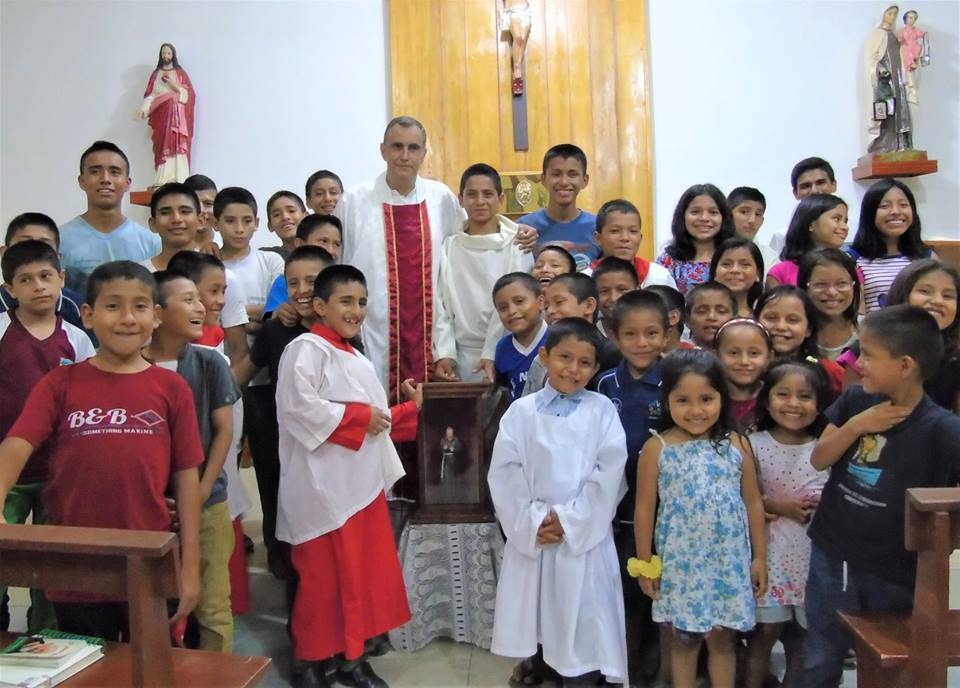
How much would you pay for a 14-year-old boy?
This was a question Father Ignacio María Doñoro, a Spanish missionary priest and military chaplain, had to answer in 2011. He was in El Salvador on a humanitarian mission with the Spanish army when he heard the story of Manuel, a young boy with partial paralysis whose parents planned to sell him to organ traffickers to feed their other four children. The price tag? $21.
Father Ignacio tracked down the family and offered to pay more for the boy. They settled for $25. It was the first time he had “bought” a person. Though he had saved countless babies from abortion by providing their mothers with spiritual and material support, this was the first time he saw the face of a child he was rescuing from certain death.
“When I saw what was happening, I thought, ‘I can do one decent thing in my life—perhaps shorten my time in purgatory—by rescuing this child,’” the missionary said in an interview with the Spanish office of The Pontifical Mission Societies. “So, I became a human trafficker and saved him.”
With medication and extensive physical therapy, Manuel recovered from his paralysis. Years later, Father Ignacio received a letter from the boy, now grown, thanking him for saving his life.
That moment led him to a deeper realization: there is a reality beyond what most people know. The trafficking of human beings—organ harvesting, forced prostitution, or slave labor—is one of the most heinous crimes in existence. It is currently the third most profitable illegal industry, following arms and drug trafficking.
Though only 0.2 percent of organ trafficking crimes are detected, the United Nations estimates that the industry generates between $840 million and $1.7 billion annually. About 10% of all organ transplants— approximately 12,000 per year—are believed to be illegal.
A Call Beyond Comfort
“From there, I went on humanitarian missions with the army to Colombia, Tangier, and Mozambique,” Father Ignacio recalls. “Until one day, 14 years ago, after having built platforms and fundraisers, I realized that giving money and organizing things wasn’t enough.”
What truly matters, he concluded, is giving oneself.
“Life is too short to waste time,” he says. “My advice is always to live life intensely, giving yourself to others, as Jesus did. ‘There is no greater love than this—that a man should lay down his life for his friends’” (John 15:13).
That conviction led him to a radical decision: against reason, against logic, against the advice of his family and even his fellow priests, he moved to the world’s most forgotten corner.
That forgotten corner is Madre de Dios (Mother of God), located in the apostolic vicariate of Puerto Maldonado, and known as the door to Peru’s Amazon rainforest.
“It is a place where the human person is worth nothing, where people are trafficked, where terrible material poverty creates terrible moral poverty,” he explains. “There are many places here where, surprisingly, a priest has never set foot.”
He is not exaggerating. In vast regions of the Amazon, no priest, religious sister, or missionary has ever been. Of the world’s 4.5 billion non-Christians, an estimated 80 percent have never even met a Christian.
It was in Madre de Dios that Father Ignacio built Hogar de Nazaret, a refuge for children rescued from human trafficking. And, like many missionaries who confront organized crime—in his case, the illegal mining industry—he became a threat to business.
A Brush with Death
“In March 2015, I woke up to three guns pointed at my face,” he recalls. “The criminals had realized that I was the one moving the strings to save these children.”
After tying his hands and feet, the men beat him mercilessly.
“They shouted at me, ‘You are going to die priest!’”
When he first arrived in Madre de Dios, he had been advised to carry a gun for protection. He rejected the idea, believing a priest shouldn’t carry a weapon. But as he lay on the ground, bleeding and broken, he briefly regretted that choice.
“I was in so much pain that I passed out,” he says. “When I regained consciousness, they were still there. And when it became clear they would uphold their promise to kill me, I knew my last thoughts couldn’t be about the weapon I didn’t carry.”
Instead, he resolved to die forgiving.
“The most positive thing I could think of was the conversations I’d had with mothers considering abortion—mothers who instead had chosen life. Hundreds and hundreds of babies saved,” he says. “That psychological joy allowed me to overcome the physical pain.”
Pretending to be dead saved his life.
After the attack, he returned to Spain for medical treatment. But as soon as he was cleared, he went back to Peru, relocating Hogar de Nazaret to Bellavista and Carhuapoma, still within the Amazon.
“I don’t believe I decided anything,” he reflects. “I have the feeling that I was sent. One of the most ‘dangerous’ things a Christian can say is, ‘Lord, do with me what You will. I am in Your hands.’”
A Home for the Broken
At Hogar de Nazaret, Christ, the Eucharist, and the Virgin Mary are the foundations. Here, some 300 children are not only cared for, fed, and educated, but above all, they are shown the love that God has for them. Heaven is the place to which they are called and to which they should aspire as the main objective in their lives.
“There are 40 priests serving about 100 communities in the prelature of Moyobamba, where our home is located,” he says. “The children arrive completely broken—physically and emotionally. They have infections and rotting limbs. Their stories are harrowing: they have been exploited, abused, prostituted. They have a resilience that I know I wouldn’t have. Honestly, if I had been through what they have suffered, I would have taken my own life.”
The words of Christ guide everything the Hogar does: “Let the children come to me.”
“In both homes, the Eucharist is at the center, the beating heart of this place,” he explains. “We are convinced that Jesus will heal them. These children have never received proper medical care, so they respond to it quickly. But beyond that, when a person feels loved, needed, irreplaceable, unique, special—the healing is not just emotional, it is also physical.”
For Father Ignacio, the most significant problem in the Church is our failure to believe Jesus when He says:
“Come, you who are blessed by my Father. Inherit the kingdom prepared for you from the foundation of the world. For I was hungry and you gave me food, I was thirsty and you gave me drink, a stranger and you welcomed me, naked and you clothed me, ill and you cared for me, in prison and you visited me” (Matthew 25:34-36).
“It is Jesus who is naked,” he says. “It is Jesus who is hungry. It is Jesus who has been beaten. It is Jesus who has been trafficked. It is Jesus who has been raped. It is Jesus who arrives broken. But it is also Jesus who laughs when a rescued child plays soccer. It is Jesus who smiles when a child whose life you saved smiles at you.”
When asked about the ultimate goal of Hogar de Nazaret, Father Ignacio’s response is unwavering:
“To console the heart of Jesus. Because the passion of these children—crucified by organized crime—is a continuation of the Passion of Christ.”


